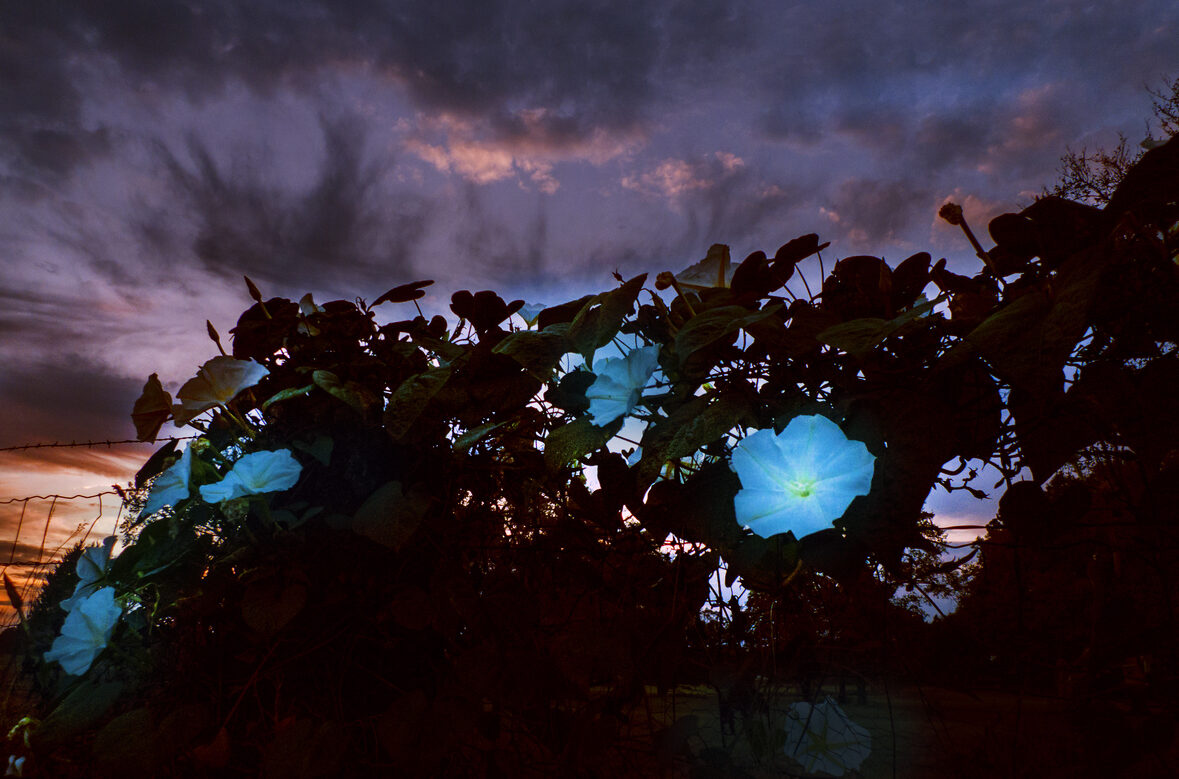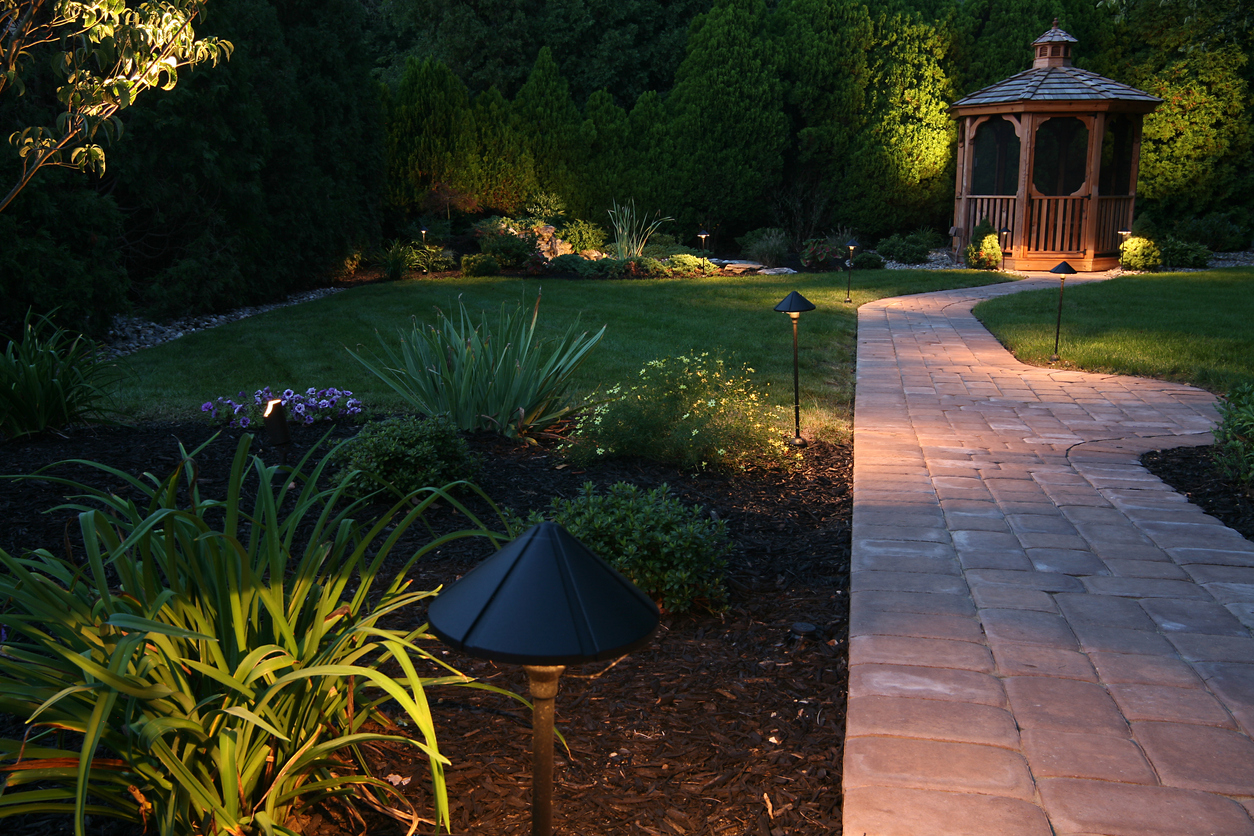

We may earn revenue from the products available on this page and participate in affiliate programs. Learn More ›
Spending time in the sun might be synonymous with gardening for many, but there’s plenty of beauty to be found during moonlit summer evenings. Moon gardens are among the most inspiring types of themed gardens. Even better, you don’t need a ton of space or a rare plant collection to get a moon garden going. It’s possible for yards of any size to have a moon garden that features plants ranging from fragrant annuals to hardy perennials.
What Is a Moon Garden?
Whether a dedicated garden bed or a larger nook in your yard, a moon garden is an enchanting landscape idea. Intended to be enjoyed by the light of the moon, a moon garden is full of plants that reflect moonlight, such as white flowers, silvery foliage, and night-blooming plants. Many moon garden ideas also incorporate decorative lawn elements that reflect moonlight, like gazing balls, water features, and light-colored stonework. The best location for a moon garden is a matter of preference, but they are often enjoyed from a patio, deck, or path.
Moon Garden Must-Haves
From moon flowers that bloom at night to soft and silvery foliage to bright white flowers, plants that look stunning at night are at the heart of any moonlight garden. The following plants are popular for moon gardens, but keep in mind that some can be toxic to cats, dogs, and people. If you plan to share your moon garden with pets or small children, you may want to opt for nontoxic flowers and foliage.
RELATED: The Best Lawn Ornaments
Night-Blooming Flowers
A popular choice for moon gardens, flowers that open at night offer visual appeal and attract unique pollinators. The U.S. Fish and Wildlife Service encourages growing moon gardens to help support nature’s hardworking creatures of the night like fireflies, moths, and bats, who can gather pollen from the sanctuary of a garden full of night-blooming plants. Night-flowering tobacco, datura species, and moon flowers all join the ranks of night bloomers, along with yucca and night blooming jasmine.
Our Recommendation: Giant White Moonflower Seeds at Burpee for $4.95.
Not only is this heirloom variety a stunner at night, it’s fragrant, grows quickly, and vines out to 15 feet.

White Flowering Plants
Although many night-blooming plants are white as well as fragrant, any plant with white flowers that remain open can be a stunning moon garden addition. By day, lots of white flowers can produce a monochromatic garden effect; by night, the bright white of the flowers will stand out in the moonlight. White flowering plants include white roses, white hydrangea, viburnum, sweet alyssum, dahlias, and shasta daisies, as well as white annuals like petunias.
Our Recommendation: Fragrant Moonlight Garden Collection at Breck’s for $29.99.
This moon plant selection offers everything you need to get started, including a suggested layout for planting.
Flashy Foliage
Moon garden flowers aren’t the only showstoppers at night. Plants with silvery and white variegated foliage look stunning in the moonlight and provide textural appeal in any landscape. Silver plants include varieties of artemisia, such as silver mound, wormwood, and mugwort. Also look for plants with white-and-green variegation, such as the variegated shrub dogwood or low-growing lamium (aka deadnettle). The luminous white of the variegated leaves will stand out day or night.
Our Recommendation: Woodworm (Artemisia Silver Mound) Plant at Etsy for $17.89.
Its silvery foliage is lacy both in appearance and to the touch, and it’s great for lining paths in USDA zones 4 through 9.
Sounds and Scents
There’s nothing quite as enticing as strolling through a garden at night and inhaling the scent of a fragrant night-blooming plant. Scented plants like gardenia and star jasmine have white flowers that stand out in moonlight while also offering rich fragrances. Other enchanting elements to add to any moon garden are well-placed garden accessories, such as a water feature or a set of wind chimes, both of which can enhance the ambiance of a relaxing night garden.
Our Recommendation: Woodstock Chimes Amazing Grace Chime at Amazon for $30.11.
These windchimes are tuned to the opening notes of “Amazing Grace” and are silver in color, so they shimmer in the moonlight.
RELATED: The Best Solar Path Lights of 2025 for Illuminating Outdoor Walkways, Tested

9 Moon Garden Layout Tips
Before breaking ground on a moonlight garden, be sure to research which plants will grow in your climate. Make sure the moon garden plants you select are not only beautiful at night, but suited to the yard’s daytime growing conditions. For example, white roses require plenty of sunlight; gardenias like shade and acidic soil. And although the general idea is that moon garden designs should be enjoyed by moonlight, they still can be admired in the day. Follow these moon garden layout tips to create a space that is dreamy both day and night.
- Avoid planting a moon garden where large trees might block a lot of moonlight.
- Use subtle solar lights for those dark nights of the new moon.
- Add a central place to sit and enjoy the sights and sounds of the garden in the evening, such as relaxing Adirondack chairs or an outdoor bench.
- Always plant according to height so that ground covers like alyssum can spread out and be seen.
- Give plants plenty of room to grow to ensure each individual plant’s foliage and flowers are visible.
- Consider a central feature like a gazing ball or bird bath that will reflect the moon and stars.
- Use light-colored stones, like gray or white gravel, to create a visible path that lightly reflects moonlight.
- Consider planting in a semi-circle or crescent shape, with seating placed in the middle of the plants for optimal moonlight basking.
- If space is a concern, plant a single bed or even a selection of pots grouped together with white, silver, and night-blooming plants.
